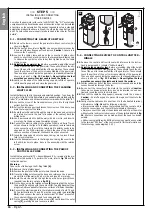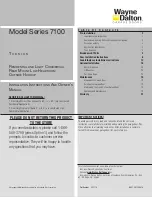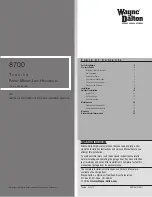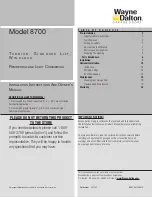
KNOWLEDGE OF THE PRODUCT AND PREPARATION FOR INSTALLATION
––– STEP 2 –––
2.1 - PRODUCT DESCRIPTION AND INTENDED USE
The series of devices and accessories stated in this manual (some of
which are optional and not present in the kit), make up the automation
system named “WT”, designed for a gate or door with one or two swing
leafs.
Any other use than as specified herein or in environmental con-
ditions other than as stated in this manual is to be considered
improper and is strictly prohibited!
The main part of the automation comprises one or two electromechanical
gearmotors (depending on the number of leafs to be automated), each
equipped with a DC motor and epicyclical gear reducer. The geamotors
have an articulated arm, the length of which can be shortened during
installation when there is a fixed obstacle over the gearmotor (wall, pole or
other) preventing complete rotation of the arm and therefore maximum
leaf opening.
The WT1SC is equipped with a control unit that powers and manages
operation of all connected devices. The control unit implements “ECS-
Bus” technology, which enables connection and communication between
multiple devices, using a single bus cable with 2 internal wires. The con-
trol unit incorporates a radio receiver for reception of the commands sent
by the user by means of the GTX4 transmitter. The system can memorise
up to 256 transmitters (if memorised in “Mode I”) and up to 6 pairs of
PH100 photocells.
The automation can be powered by the mains (230 V) or alternatively by
the PF photovoltaic system. If powered by the mains, a backup battery
(mod. PR2, optional accessory) can be installed in the control unit to
enable a number of emergency manoeuvres following a power failure
(black-out). During the power failure, or at any other time, the gate leafs
can be moved manually if required, by first releasing the gearmotor using
the relative key.
2.2 - DEVICES AND ACCESSORIES REQUIRED TO SET
UP A COMPLETE SYSTEM
Fig. 1
illustrates all devices and accessories required to set up a complete
system, such as that shown in
fig. 4
.
[
a
] - Electromechanical gearmotor WT1SC with control unit
[
b
] - Electromechanical gearmotor WT1SK without control unit
[
c
] - Curved arms + slotted arms
[
d
] - Front brackets (for fixture of gearmotor to the gate)
[
e
] - Rear supports (for fixture of gearmotor to wall)
[
f
] - Keys for manual release of gearmotors
[
g
] - Pair of photocells PH100 (wall-mounted)
[
h
] - Key-operated selector switch KS100 (wall-mounted)
[
i
] - Hand-held transmitter GTX4
[
l
] - Flashing light FL100
[
m
]- metal hardware (screws, washers and elbow fitting for arms)
[
n
] - Buffer battery PR2
Warning!
- Some devices and accessories stated herein are option-
al and may not be present in the kit (refer to the Mhouse product cat-
alogue).
[
a
]
[
c
]
[
b
]
[
e
]
[
d
]
[
i
]
[
m
]
[
g
]
[
n
]
[
l
]
[
h
]
[
f
]
1
Important notes on manual consultation
o
In this manual, the text “WT system” refers to the entire series of devices that make up the automation.
o
This manual describes how to set up a complete automation, such as that shown in
fig. 4
. Some of these devices
and accessories are optional and may not be present in the kit. For a complete description, refer to the Mhouse
product catalogue or visit the website www.mhouse.biz.
o
In the first section of the manual (up to chapter 10) all subjects are dealt with in the same order as they are to be
performed. Therefore, to facilitate installation and programming, and to ensure personal safety, read the manual
first, to ensure full comprehension of the tasks to be performed, and then perform the work itself, completing all
tasks in the order in which they are described.
English
English –
3
Summary of Contents for WT1S
Page 11: ...1 2 3 4 45 3 1 2 a c b OK b a a b c d b a 5 6 7 8 9 10 11 12 13 13 English 10 English...
Page 14: ...OK b a 1 2 17 AA ok BB no OK 18 1 2 16 3 4 2 1 English English 13...
Page 15: ...b a 1 2 3 4 5 6 20 a b 1 2 3 4 19 English 14 English...
Page 36: ...Technical Documentation English English 35...
Page 37: ...English 36 English...
Page 39: ...English 38...
Page 41: ...English 40 English...
Page 44: ...Goniometer English English 43...
Page 45: ...44 English English Goniometer...





































